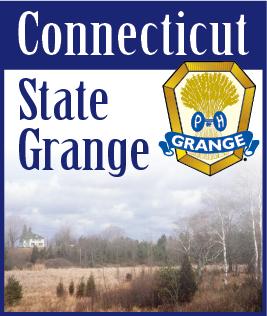| APRIL 10, 2011 -- Years ago, Anson Davis, the son of Colonel John Davis, was the leading landowner in the Great Hill area. In those days, the Naugatuck Valley produced many cattle and saw many droves of young stock sent from the north to be fattened and butchered here. Anson was a major cattleman, raising the grain and corn to supplement his pasturelands.
When Anson’s son Marcus married, he was given a house and farm on his father’s land. Marcus was, by reputation, a bit lazy, but he was inventive and willing to try new ideas. When a nurseryman from New Jersey offered to sell Marcus some peach trees, Marcus decided to grow peaches on Great Hill, although the sweet fruit had not yet been grown any farther north than New Jersey. He started what was the first peach orchard in the Naugatuck Valley. Marcus would take a wagonload of peaches to new Haven, selling them for the $5 a bushel, and come back with a load of fertilizer for his orchard and that of his son-in-law, Michael Coleman.
Marcus was not the only Connecticut man interested in peaches at the time. John and George Hale, brothers in Glastonbury started a nursery business there. John was active in the Grange. At a Grange meeting in Shelton, John and Michael Coleman happened to meet. Coleman told Hale about the success that his father-in-law, Marcus Davis, had with peaches.
Hale was impressed with Coleman and proposed they go into the peach business together. Coleman guided Hale around Seymour and Oxford. When Hale saw Moose Hill, he decided to buy land there. The 1896 purchase led to the first planting of peach trees on what was to become the Hale-Coleman Peach Farm.
Coleman’s son Arthur wrote, “There was money in growing peaches in the early years of the century, and the Hale-Coleman partnership rolled it in, once the trees began bearing. By 1906, Mr. Hale was not satisfied to have no house on the property, save the small one on Hell Lane.
He declared: "Let's build one worthy of such a project as ours!" And with 18,000 trees coming into bearing, a big house was indeed called for. So was started, in the summer of 1906, what was for the times a veritable mansion atop Moose Hill – a property from which on clear days offered views as far as Long Island Sound. The family of Michael Coleman moved into the new house in March 1907.
The Hale-Coleman partnership prospered for six years before it broke up. Arthur Coleman wrote, “All those years at the Hale Orchards, and we never dreamed they would end. But they did, in March 1912, when on a moral issue involving the way Mr. Hale was using our home as a love-nest, my mother persuaded my father that she could not raise three children properly in such an atmosphere. My father knew that wrenching himself from all he had worked so hard for so long would be a shattering experience, and for a time he resisted my mother's demands. But in the end, he had to give way. And so the Hale-Coleman partnership was dissolved.”
The Colemans set up an orchard in Cheshire. When Hale died in October 1917, he left the whole of the Moose Hill Estate to his secretary, Miss Sperry. Arthur Coleman’s wife, Marion, wrote, “The minute the will was read, she rushed to Seymour and had the deed recorded. Mr. Hale had lived with her for some years before his death.”
The Hartford Courant reported on April 24, 1918 that the value of the Hale Estate was $182,000, and that the Hale family was challenging the transfer of the Great Hill property to Miss Sperry. The Moose Hill Farm, in Seymour and Oxford, which consisted of 180 acres, houses, storehouses, etc., was valued at $30,000; and the James Farm, in Oxford and Seymour, was valued at $57,108, a price that included property as well as tools, horses, wagons, apple barrels, barrel hoops, Ford touring cars, dusting machines, spraying outfit, camp furnishings for fifty men, mowing machines, plows, harrows, small tools, harnesses, six tons of hay, etc.
The Courant reported, “It is understood that a settlement of the threatened contest is to be reached. Stancliffe Hale, the executor, protested that the property named in the preceding paragraph, deeded to Miss Frances Sperry, who had been Mr. Hale's secretary, should be included in the inventory.”
Marion Coleman wrote, “The Hale children were shocked and unnerved by the loss of Moose Hill, as they had loved it more than any other of their father's far flung properties. They had been given a huge plantation in Georgia, also set out to peaches, but this had no sentimental value for them, and so they sold it. With the money received from the sale, they went to Miss Sperry and persuaded her to sell Moose Hill to them. She had no idea what to do with a peach empire other than to sell it, and why not to the Hales? Thus, the Hale children found themselves in possession of their beloved Moose Hill. They, like Miss Sperry, had no idea what to do with such an empire, and so they went to Michael Coleman and invited, nay urged, him to come back to the old place and run it again. This he did. He had left in 1912; he returned on Nov. 9, 1918.”
The Oxford Historical Society celebrates the history of the Peach Farm each August with a Peach Festival, featuring photos and information on the Peach Farm, plus selected Oxford history subjects. The Festival is held the weekend before Memorial Day and has featured homemade Peach Shortcake and Rich Farm Peaches and Cream Ice Cream. |
